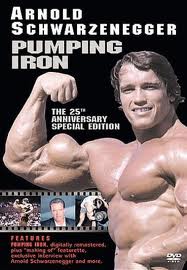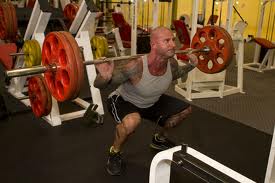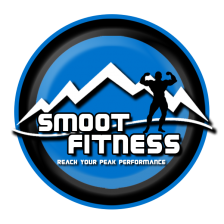I think it is a pretty safe assumption that 99% of people have an ideal physique pictured in their mind that they would like to achieve, and a certain amount of weight that they would love to man handle on a regular basis. How does one go about turning these dreams in to reality? Through proper training, good nutritional practices, dedication, willingness to make sacrifices, and relentless hard work. Unfortunately, there are so many training protocols and philosophies in circulation that individuals new to training don’t know where to start, and advanced trainees second guess themselves, changing the methods that have produced great results for years. Couple that with thousands of nutritional practices that all contradict one another and you have created a recipe for mental disaster. Everyone has been guilty of complicating things more than they should, and it usually revolves around training plans, training variables, or the small details of a diet. The key is to realize you are making things hard on yourself, and return to what worked in the first place: simplicity, strategy, and consistency
Training Plan
One quote I heard a long time ago that really stuck in my mind was “If you fail to plan, you plan to fail.” I believe that having a plan on paper makes the difference between a good workout and a great workout. It enables you to mentally prepare for an upcoming training session and analyze lifts from previous workouts to ensure that you progress in some way during upcoming sessions. Steady progress made week to week, month to month, and year to year is the path that leads to any physique or performance goal. The challenge lies in finding a plan that provides OPTIMAL results for you. Every individual is unique and is going to respond differently to a training program. The solution is to try different things and finish every plan you start until you figure out what provides the best results. Changes do not happen overnight, and jumping from one program to the next every few weeks or months will simply have you spinning your wheels.
For those new to training, hiring a coach to design your plan is the best route in my  opinion. They will design a plan that is individualized for you and teach you reasons behind the programming if they are worth anything. If coaching is not an option, programs like Starting Strength and 5X5 are great plans to start with as well. It is important to note that these plans provide good results for a large group of people, but not incredible results for one individual. This is largely because any stress that the body is not used to will cause it to grow/strengthen in order to adapt to the new demands placed on it. Everyone will see results because of the new stimulus and stress to their body when starting a new program. However, results will greatly vary. Eventually it comes down to education, trial and error, and working with those better than you that will solve the mystery of the optimal plan.
opinion. They will design a plan that is individualized for you and teach you reasons behind the programming if they are worth anything. If coaching is not an option, programs like Starting Strength and 5X5 are great plans to start with as well. It is important to note that these plans provide good results for a large group of people, but not incredible results for one individual. This is largely because any stress that the body is not used to will cause it to grow/strengthen in order to adapt to the new demands placed on it. Everyone will see results because of the new stimulus and stress to their body when starting a new program. However, results will greatly vary. Eventually it comes down to education, trial and error, and working with those better than you that will solve the mystery of the optimal plan.
Advanced lifters with a great physique, strength, and who have seen steady results for years do not need to make drastic changes to their plan. There is a big difference between utilizing tips from another coach/lifter, and completely remodeling your training. I have never seen someone do so and achieve more performance/gains. If it is not broken, don’t fix it. Once you have solved the formula that works for you, never lose sight of the solution.
Exercise Selection
One of my favorite movies that I watched as a young child was Pumping Iron. Arnold had a better physique than every action figure that I owned, and watching him squat hundreds of pounds ass to grass made me want to make a midnight gym run. Too bad it was a school  night and the gym had an age limit. However, I was able to pick up on some important principles while I was formulating my plan to sneak past the gym’s front desk, and it was because I was not just focused on Arnold’s bulging biceps, massive chest, or incredible strength. I was interested in HOW he developed it all, and one thing that stuck out to me was his exercise selection. Arnold did not have the luxury of Cybex machines, bosu balls, or shake weights. He took an iron barbell or dumbbell through specific movement patterns that stimulated the largest amount of muscles possible. He did so with heavy weight and high amounts of volume, and despite having such a small arsenal of equipment, Arnold developed arguably the greatest physique in history. Heavy compound lifts require more muscular involvement, lead to the release of more anabolic (muscle building) hormones, increase stability, mobility, increase proficiency of various movement patterns, create more muscular damage, and ultimately stimulate more growth. When choosing exercises, compound lifts should form the foundation of any training plan, and they should be performed before isolation exercises when the body is not fatigued. It is nice to have the ability in this day and age to add machines and cables in to a plan to isolate a muscle group and provide a different stimulus. However, the top power lifters in the world did not achieve a 500 pound bench press from performing massive amounts of machine flies.
night and the gym had an age limit. However, I was able to pick up on some important principles while I was formulating my plan to sneak past the gym’s front desk, and it was because I was not just focused on Arnold’s bulging biceps, massive chest, or incredible strength. I was interested in HOW he developed it all, and one thing that stuck out to me was his exercise selection. Arnold did not have the luxury of Cybex machines, bosu balls, or shake weights. He took an iron barbell or dumbbell through specific movement patterns that stimulated the largest amount of muscles possible. He did so with heavy weight and high amounts of volume, and despite having such a small arsenal of equipment, Arnold developed arguably the greatest physique in history. Heavy compound lifts require more muscular involvement, lead to the release of more anabolic (muscle building) hormones, increase stability, mobility, increase proficiency of various movement patterns, create more muscular damage, and ultimately stimulate more growth. When choosing exercises, compound lifts should form the foundation of any training plan, and they should be performed before isolation exercises when the body is not fatigued. It is nice to have the ability in this day and age to add machines and cables in to a plan to isolate a muscle group and provide a different stimulus. However, the top power lifters in the world did not achieve a 500 pound bench press from performing massive amounts of machine flies.
Other Training Variables
The principle of variation states that no matter how effective a training program is, it will only be effective for a short period of time. A new stimulus must be imposed on the muscles or continued progress will be stagnated (Jim Stoppani). The majority of people understand this principle, but many let it overshadow arguably the most important principle of all, specificity. Simply put, specificity states that training should be specific to the goal.  A person training for strength is not going to perform 6 sets of 20 repetitions, and a football player is not going to perform hours of batting practice in the batting cage. When deciding on exercise selection, exercise order, rest time, number of sets, number of reps, etc., realize that you can only effectively train for one adaption at a time. Imposing a new stimulus before adapting to the old one is almost as ineffective as not training at all. Focus on one goal, design your plan to accomplish it, and do not move on to another goal until you reach the first one.
A person training for strength is not going to perform 6 sets of 20 repetitions, and a football player is not going to perform hours of batting practice in the batting cage. When deciding on exercise selection, exercise order, rest time, number of sets, number of reps, etc., realize that you can only effectively train for one adaption at a time. Imposing a new stimulus before adapting to the old one is almost as ineffective as not training at all. Focus on one goal, design your plan to accomplish it, and do not move on to another goal until you reach the first one.
Nutrition
Nutrition accounts for 80% of results, and I tend to see more shipwrecks when it comes to nutritional practices than training. I feel this is due to people stress too much over being perfect that they get frustrated and give up. They get caught up in the numbers, clean vs. dirty foods, worrying about which diet philosophy is the best, and they fail to focus on what truly matters: long term results. Nothing is ever black and white. Caloric intake/Macro distribution is going to vary based on age, activity level, lean mass, height, hormones, stress, genetics, etc. There is a HUGE grey area. The key is to keep it simple and make adjustments as needed.
Bulking
If weight gain is the goal, a caloric surplus needs to be maintained from day to day. A slight surplus of 200-300 calories over maintenance will be enough to slowly put on lean mass while minimizing fat storage. Taking the surplus up to 500-1000 calories will not lead to more muscle mass, only more fat storage. The determining factor in the size of the surplus when I bulk is how often I am going out with my friends and how much fat I mind putting on that I will have to cut off later. I do not think it is smart to meticulously track macros during the offseason for the majority of people. Have an idea of what you are eating and stay relatively close to it, but allowing freedom to go slightly over or under the macros goes a long way in maintaining sanity. Save the mental warfare for the last few weeks of contest prep. The offseason is the time to have fun, in moderation of course.
Cutting
When dieting to lose body fat, I feel that everyone should eat as much food as possible while still losing weight. If the diet begins with a 1000 calorie deficit from maintenance and you have 30 pounds to lose, your metabolism will not be thanking you at the end of a 20+ week cut (if you even make it to the end). Remember that it is a marathon, not a sprint, and the tortoise always wins the marathons.
Now while I do not believe that food choices matter in terms of body composition, I strongly  believe that they affect health, performance, and satiety. For optimal health, people should try to build the foundation of their intake on the largest variety of nutrient dense foods possible that they enjoy eating. These foods tend to drive optimal performance and keep you satisfied while calories are low. As long as the majority of food is nutrient dense, there is no problem in fitting so called “junk food” in to your diet plan. Now if health and hunger are of no concern, consume all of your carbs from table sugar, make sure it fits your macros, and adhere to the program. I’m not sure what your insides will look like, but you will most likely hit the stage with striated glutes. At the same time I do not feel that meal timing affects body composition either, but it has a large effect on adherence to a program. Eating eight 300 calorie meals would drive me crazy when my total intake is low. Eating a few larger meals makes me perceive that my intake is high, and perception is extremely important as the mind always fails before the body. In reality it all comes down to individuality and personal preference. Every dietary approach is a different path toward the same destination. Some will have more roadblocks than others, but results are dependent upon finishing the trip.
believe that they affect health, performance, and satiety. For optimal health, people should try to build the foundation of their intake on the largest variety of nutrient dense foods possible that they enjoy eating. These foods tend to drive optimal performance and keep you satisfied while calories are low. As long as the majority of food is nutrient dense, there is no problem in fitting so called “junk food” in to your diet plan. Now if health and hunger are of no concern, consume all of your carbs from table sugar, make sure it fits your macros, and adhere to the program. I’m not sure what your insides will look like, but you will most likely hit the stage with striated glutes. At the same time I do not feel that meal timing affects body composition either, but it has a large effect on adherence to a program. Eating eight 300 calorie meals would drive me crazy when my total intake is low. Eating a few larger meals makes me perceive that my intake is high, and perception is extremely important as the mind always fails before the body. In reality it all comes down to individuality and personal preference. Every dietary approach is a different path toward the same destination. Some will have more roadblocks than others, but results are dependent upon finishing the trip.
I keep protein higher on a cut, around 1.3-1.4 grams per pound of bodyweight, because there are less carbs and calories available for energy. Fats are around .4 grams per pound of bodyweight, and carbs fill in the rest. When weight stalls, I subtract another 100-250 calories from my diet, and continue to make adjustments on a weekly basis.
Conclusion
No matter how well a training or nutrition program is developed, it will not work if it is not specific to the goal. The benefit of having so many training and nutrition methods is that there are unlimited options to create a new stimulus and achieve results. However, trying to use all of them at once will produce subpar results and lead to lack of motivation, lack of adherence, and stress. Constantly strive for success in small, short term goals, focus on the bigger picture, learn all that you can, and stay consistent. Those are the pieces that fit the puzzle of greatness.
Like What You See?
Get the Smoot Fitness Guide to Getting Stronger - FREE.

Leave a Reply